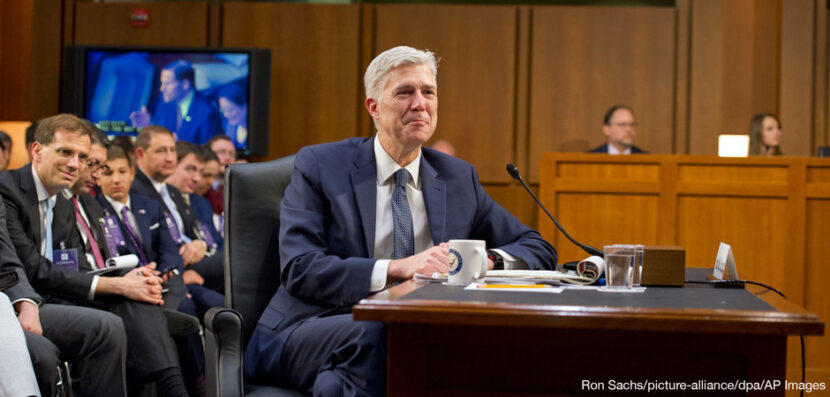- Current Events New Alabama Congressional District Selects Candidates
- Current Events Nebraska Rejects Winner-Take-All Proposal
- Citizenship Voting Under Age 18
- Citizenship Citizenship in Action
- Democratic Party Biden’s and Trump’s Recent Primary Results
- Elections Trump and Biden Win South Carolina and Michigan Primaries

Hearings Begin for Supreme Court Nominee
Back in February, Election Central brought you a closer look at the Honorable Neil Gorsuch, President Trump’s pick to fill the Supreme Court seat vacated by the death of Justice Antonin Scalia in February, 2016. Last week, hearings on Gorsuch took place in the U.S. Senate.
The Questioning
For three days, Gorsuch answered senators’ difficult questions on issues such as abortion, gun control, campaign spending, and whether or not he would allow cameras in the Supreme Court. Many Senate Democrats were unsatisfied with Judge Gorsuch’s answers, which were often very cautiously worded and not very specific. (Note, however, that this has been the strategy of all recent Supreme Court nominees–regardless of whether they were nominated by a Republican or a Democratic president.)
Gorsuch said he rules fairly and always according to the law. Gorsuch would not commit to a direct point of view on many of the important issues the senators brought up. The senators–especially the Democratic ones–were always trying to get specifics on how Gorsuch might rule on these controversial legal issues.
On the fourth day of the hearings, Gorsuch himself was not present while judges, civil rights leaders, activists, professors, and other professionals debated his nomination.
The Senate’s Response
Predictably, the members of the Senate–who will be responsible for voting in support or denial of Gorsuch taking Scalia’s place on the Court–seem split along party lines. Democrats worry that Gorsuch is too conservative and will not act as a check on President Trump. They are concerned about his record on civil liberties, reproductive rights, and election laws, and claim that he favors the rights of corporations over individuals. Republicans, however, argue that Gorsuch has a strong legal record and will be able to leave his personal views at home. Gorsuch himself insisted during the hearings that he makes up his own mind about cases, regardless of what the conservative White House wants him to do.
Going Nuclear?
The mathematical reality, however, is that the Republicans hold a strong enough majority in the Senate that the Democrats may be unable to prevent Gorsuch’s appointment to the Supreme Court. Faced with Gorsuch’s probable confirmation, Democrats are trying to find ways to halt or delay the vote. Senate Minority Leader, Democrat Charles E. Schumer, has vowed to filibuster the vote on Gorsuch, and three other Democratic senators have agreed to filibuster as well. However, they will need at least 40 senators to keep a filibuster going for any length of time.
If the filibuster is successful–and the Democrats manage to block the vote–Republicans will need 60 votes to overcome it. (It takes 60 to break the filibuster and get to the vote in the first place.) But there are only 52 Senate Republicans, which means that Gorsuch will need to win over at least eight Democrats to break the filibuster.
If this doesn’t happen, there is a chance that Senate Republicans will invoke the “nuclear option,” which is a maneuver in which the majority party changes the Senate rules to lower the number of approval votes needed, from the tradition of 60 to a simple majority. This would allow Gorsuch to be confirmed by only 51 senators. (With 52 votes, Republicans automatically have the majority.)
The problem with the nuclear option is that it makes the filibuster–an important minority party political tactic–irrelevant. It also makes it so that future Supreme Court nominees will have an easier time getting approval, which will give the president less incentive to pick a relatively mainstream nominee. Furthermore, what is to stop the majority party from using this option to overrule the minority party on any other piece of legislation as well?
As a result, senators from both parties are wary of “going nuclear.” It alters the long history in the Senate of trying to find bipartisan compromise and hold itself as being more stable than the House of Representatives–which has a much longer history of being highly partisan and less interested in compromise. It’s possible that members of both parties will be able to work together across the aisle to reach a compromise that will keep the traditions of the Senate intact.


